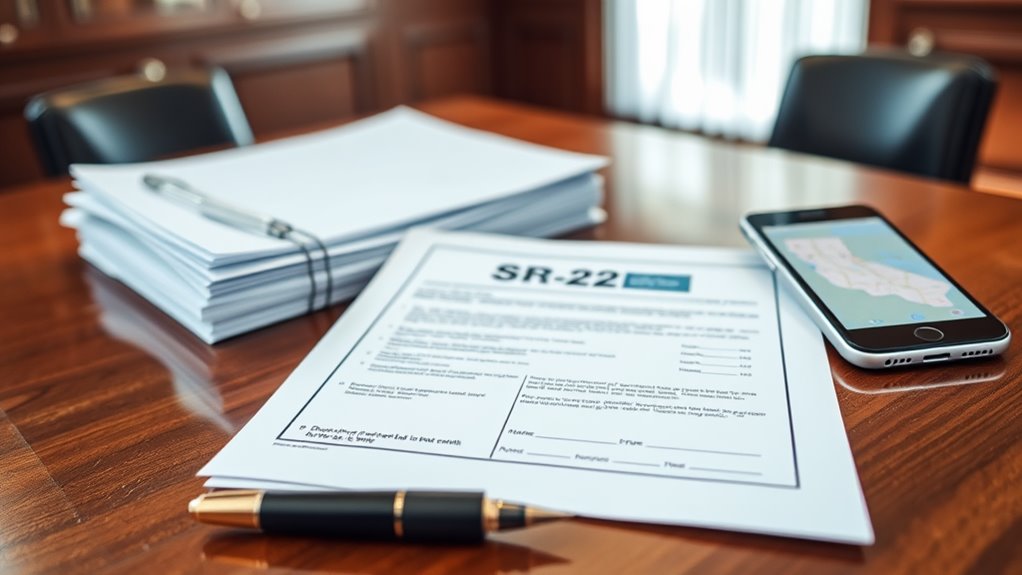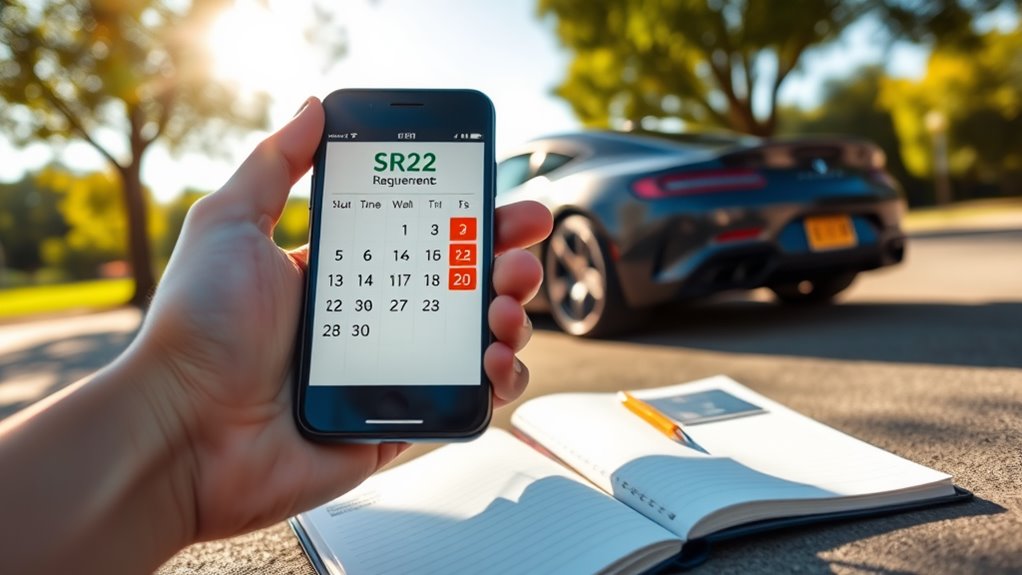Tips to Reduce Your SR22 Insurance Costs
Imagine standing at a crossroads, weighing your options to lower your SR-22 insurance costs. You might feel overwhelmed by the choices, but there are strategic steps you can take to lighten the financial burden. By comparing quotes, adjusting your coverage, and exploring discounts, you can make informed decisions that impact your premiums. What if there are even more ways to save that you haven’t considered yet? Let’s explore these strategies further.
If you’ve recently found yourself needing SR-22 insurance due to a serious driving offense, you’re likely concerned about the potential costs. Understanding that SR-22 isn’t a type of insurance but rather a certificate verifying compliance with state minimum liability coverage requirements is essential. It’s typically required for high-risk drivers who’ve faced serious violations like DUIs or reckless driving.

Unfortunately, obtaining this certification often leads to increased auto insurance premiums, and maintaining it can last several years. However, there are strategies you can use to mitigate these costs.
First, it’s important to compare different insurance companies. Not all insurers handle SR-22 filings the same way, with some focusing specifically on high-risk drivers. By comparison shopping, you can find the most affordable rates. Utilizing online comparison tools allows you to gather multiple quotes easily. Some companies specialize in high-risk drivers, offering competitive rates.
Alternatively, partnering with an independent insurance agent can provide personalized assistance in maneuvering through various providers and policies. Keep in mind that different companies may offer varying rates for the same level of coverage, so investing time in this process can yield considerable savings.
Another effective tactic is to adjust your coverage and deductibles. While raising your deductible can lower your monthly premiums, be sure you have enough funds available for potential claims. Understand that a higher deductible means you’ll pay more out-of-pocket if you do need to file a claim.
At the same time, review your coverage levels to verify they meet state requirements while also being cost-effective. Dropping unnecessary add-ons or adjusting certain coverage elements can free up some cash without sacrificing important protection.
Don’t overlook the potential for discounts and incentives. Many insurers provide discounts for safe driving, completing defensive driving courses, or having certain safety features in your vehicle. Bundling multiple insurance policies, like your car and home insurance, can lead to considerable discounts as well.
Additionally, if you use telematics devices to track your safe driving habits, you might qualify for further savings. Low mileage discounts are also available for those who drive less than average, so keep this in mind.
Your payment strategy matters too. Paying your premiums annually rather than monthly can lead to savings, as many insurers offer discounts for upfront payments. Setting up automatic payments might also qualify you for additional discounts.
Make sure your payment plan aligns with your financial capabilities and budgeting preferences. Some insurers even reward timely payments throughout the policy period, so maintaining a good payment history can further reduce costs.
Ultimately, maintaining a clean driving record is critical. Avoiding additional traffic violations or accidents will greatly impact your premiums over time. A clean record can gradually lower your SR-22 insurance rates, and taking defensive driving courses demonstrates responsible behavior.
By comparing quotes and adjusting your coverage, you can navigate the maze of SR-22 insurance costs with ease. Think of it as trimming the branches of a tree; a little pruning can reveal significant savings. Embrace discounts and consider annual payments to lower your expenses further. Remember, your clean driving record is like a beacon guiding you toward better rates. By taking these steps, you’ll not only save money but also gain peace of mind on the road.
What Is Needed for SR22 Bond Documentation?
To obtain SR-22 bond documentation, you need to start with an active auto insurance policy that meets your state’s minimum liability requirements. Your insurance provider must also be authorized to file SR-22 forms with the DMV. Be prepared to pay a filing fee and provide personal information, including your driver’s license number. Understanding these steps is essential, but there are additional nuances and potential pitfalls you should consider before proceeding.
When you face the requirement for an SR-22, it’s important to understand that this certificate of financial responsibility is more than just a piece of paper; it’s an essential document that proves your vehicle insurance meets state minimum liability requirements. The SR-22 is typically mandated for what’s classified as “high-risk” drivers—individuals who’ve been convicted of serious offenses like DUI or those caught driving without insurance. Depending on your circumstances and the regulations in your state, you might need to maintain this certification for a period of three years. SR-22 insurance is a critical tool for ensuring compliance with these requirements.

To obtain an SR-22, your first step is to check if your current insurance provider offers this service. Not all insurers file SR-22s in every territory, so you’ll need to either add it to your existing policy or secure a new policy with a different provider who can facilitate the filing. The insurance company will then submit the SR-22 form to your state’s Department of Motor Vehicles (DMV) on your behalf.
Check if your insurer offers SR-22 services; if not, find a provider who can file it for you.
Keep in mind that there may be a filing fee, often around $25, though this can vary by state. The reasons prompting an SR-22 requirement can range from DUI convictions to multiple traffic violations. If you’ve been caught driving without valid insurance or a driver’s license, you’ll likely need an SR-22 to regain your driving privileges.
Even hardship licenses, which allow limited driving for essential needs, might necessitate this certificate. If you fail to maintain the mandatory insurance coverage required by your state, it can also trigger an SR-22 requirement. Additionally, an SR-22 is typically needed for individuals with multiple violations to demonstrate compliance with state laws.
Once you’ve secured your SR-22, it’s essential to remember the legal implications that come with it. If you allow your insurance policy to lapse, the state will be notified, which can lead to the suspension of your driving privileges. Furthermore, driving without a valid SR-22 when mandated can incur legal penalties.
In some cases, states may accept an SR-22 as an alternative to other financial responsibility forms, like cash deposits. You should also be aware that obtaining an SR-22 often comes with increased auto insurance premiums. This is a common consequence, as insurers view high-risk drivers as more likely to file claims.
The cost of these premiums can continue throughout the required SR-22 period, affecting your budget considerably. It’s worth noting that while an SR-22 is common in most states, Florida and Virginia have their version called the FR-44, which requires higher liability limits than the state minimum.
However, due to its broader acceptance, the SR-22 remains the more widely utilized option. In some instances, alternatives to an SR-22 exist, such as securing a deposit or bond, depending on state regulations. Regardless of the route you take, understanding these facets of SR-22 bond documentation is important for compliance and to guarantee you can legally operate your vehicle again.
Conclusion
Obtaining SR-22 bond documentation can feel like traversing a labyrinth, but it’s manageable with the right steps. Just like a gardener must tend to their plants to guarantee a bountiful harvest, you need to maintain continuous auto insurance coverage and keep your information updated. By following the outlined requirements, you can emerge from the process with confidence, assuring you’re legally compliant and ready to hit the road. Remember, preparation is key to avoiding any weeds of penalties!

